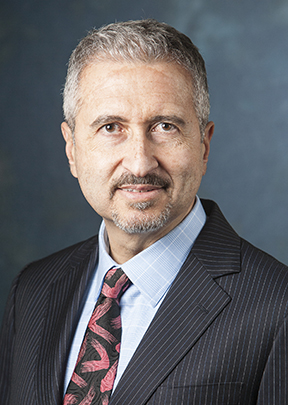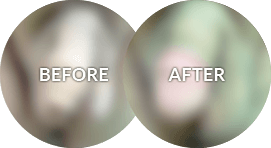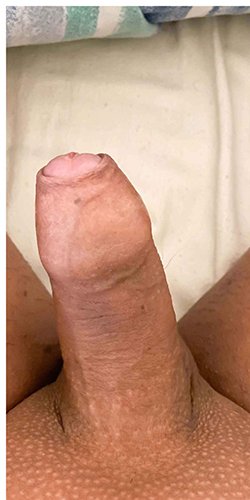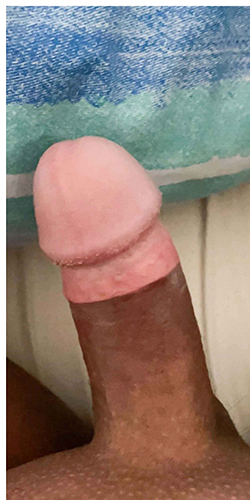Penile cancer is a condition in which cells grow and/or multiply beyond their normal rate. Cancerous cells can overtake healthy cells and invade blood vessels, muscle, soft tissue, and skin.
While a cancer diagnosis is always worrisome, you have a support system here in the San Diego area. Dr. Bidair is a regional urology expert, specializing in the improvement of penile form and function. Under Dr. Bidair’s esteemed leadership, California Adult Circumcision is a premier destination for health and wellness related to male genitalia. Schedule a consultation at our convenient location in La Mesa, California, or book a remote visit from the comfort and safety of your smart device.
Cancer is devastating, but you can beat it. Call (619) 486-5005 to enlist Dr. Bidair on your team and together, we can make cancer history.
Contents
Before and After Photos
Types of Penile Cancer
Before exploring how we can best treat penile cancer or perform reconstructive work post-cancer, we must define the various types of the disease.
Epidermoid Carcinoma or Squamous Cell
Skin cancer is the most prevalent form of cancer. Approximately 95% of all penile cancer cases can be characterized as squamous cell or epidermoid carcinoma.[1] The majority of penile skin cancer cases originate on or under the foreskin. To learn how removal of the foreskin can help prevent the risk of developing cancer, contact our office.
Sarcoma
When cancer infiltrates muscle, fat, or blood vessels, it can be categorized as sarcoma.[2] Sarcoma tumors may be more difficult to spot than skin cancer, since they are rooted deeper in the penile tissue. It is important to consult with your doctor if you suspect any early signs of penile cancer.[3]
Melanoma
The skin cells that produce pigment are known as melanocytes. Pigmentation gives your skin its signature color. But when melanocytes are stricken with cancer, the cells work overtime, becoming dangerously active. Melanoma is a skin cancer that appears as a brown, irregular splotch on the penis. Be sure to schedule an appointment with a medical expert if you notice any new or abnormal discolorations on your skin.
Basal Cell Carcinoma
Located at the base of the epidermis, basal cells are responsible for producing healthy new skin cells and pushing them out to the surface. As older skin cells die and slough away, basal cells replace them with new growth. Basal cell carcinoma occurs when the cells are overactive, presenting a raised bump that can be pearly white, waxy, reddish, brown, or even blue. Exposure to sunlight is the main cause of basal cell carcinoma, so it is less common on the penis than on more exposed parts of the body.
Causes of Penile Cancer

Cancer is unfair to its very core. It is, by definition, unpredictable in its formation and spread. While it is difficult to eradicate cancer, we can rely on data to map some of its most common causes.
Human Papillomavirus (HPV)
HPV is the most common sexually transmitted infection on earth. It manifests itself as a protrusion of warts on the genitals in both men and women. Scientists have linked the prevalence of HPV with the onset of penile cancer. While there is no cure for HPV, experts have correlated rates of human papillomavirus with uncircumcised men.[4] By removing the foreskin, you may be able to reduce the risk of developing HPV and, by association, penile cancer.
Phimosis
When the foreskin sits too tight against the glans (head) of the penis, it can cause discomfort and distress. The condition of an overly restricted foreskin is called phimosis. In extreme cases of phimosis, the man is unable to retract the foreskin at all, leading to pain and further complications. Smegma (an opaque white discharge) can build up beneath the foreskin and lead to hygiene issues.
But phimosis treatment solves more than just functional and aesthetic concerns related to a constrictive foreskin; it may also reduce the risk of penile cancer.[5] Circumcision addresses the contours of the penis to ensure that the foreskin no longer impedes proper functionality or cosmetic imperfections.
Contact California Adult Circumcision to discuss the ways in which you can lower your risk of penile cancer due to HPV and/or phimosis.
Prevention Is the Best Treatment
Nobody should have to endure cancer. It is a frightening diagnosis, to be sure, but it can be treatable, especially if you detect it early. Penile cancer may respond to radiation treatments, chemotherapy, or surgical intervention.[6] Your oncologist can coordinate her or his efforts with a skilled, trusted urologist to create the right strategy for your cancer removal.
Contact Dr. Bidair to discuss your reconstructive surgery options. It is never too early to realize your ultimate surgical goal.
When you consider the reconstruction procedure alongside the cancer removal process, you may be able to accomplish all of your wellness goals in one comprehensive surgery.
Before you need to worry about a cancer diagnosis and ensuing treatment, consider the preventative benefits of circumcision. In addition to the reduction in possible penile cancer risks, circumcision shows a correlation with lower STD rates.
Eligible Candidates for Circumcision
If you are concerned about the buildup of discharge beneath your foreskin, or if you worry that the complications of an overly tight foreskin could lead to serious health problems, contact Dr. Bidair at your earliest convenience. He can assess your risks for penile cancer and recommend the best preventative course of action.
Dr. Bidair can determine your eligibility for circumcision or restorative after-cancer penile surgery during your comprehensive consultation. If you have already received a penile cancer diagnosis, please consider coordinating your surgical approach between your oncologist and Dr. Bidair, a world-renowned urologist.
Private Consultation in San Diego

The most difficult step toward improvement is often the first step. It may be sensitive to discuss your penile cancer diagnosis, but communication is essential to creating a plan. In the spirit of great communication, we regularly update our blog. Feel free to read through our posts and bring any questions with you to the consultation with Dr. Bidair.
The doctor will perform a physical examination and ask about your battle with cancer thus far. He will use your confidential information to formulate a surgical approach that honors the form and function of your penis. Most urologists simply perform circumcisions for functional reasons. Dr. Bidair, however, takes aesthetics into account. You deserve to reclaim your pre-cancer contours, and Dr. Bidair can help you achieve your goals.
Please call (619) 486-5005 or contact us online to schedule an appointment.
Preparation and Procedure
Your preparation protocols will depend upon what stage of cancer treatment you are experiencing. Dr. Bidair will consult with your oncologist to make sure you are ready for your specific preventative or reconstructive operation.
The degree of your penile cancer treatment hinges on the nature of the cancer itself. Some types of cancer can be removed directly, often in conjunction with a circumcision procedure. Other forms of cancer require techniques such as Mohs surgery, which is a layer-by-layer removal of skin cancer with microscopic precision. The duration of your procedure will depend on which surgical method you are receiving.
Healthy Recovery
Circumcision and penile cancer treatment are delicate procedures. Dr. Bidair will provide you with the necessary postoperative medications to keep you healthy and comfortable. You may be advised to wear supportive undergarments during your recuperation period. Do not engage in sexual activity for approximately 2-4 weeks following a circumcision.
Empowering Results
Whether you need reconstruction of penile tissue that was lost to cancer, or a circumcision to try and prevent such an occurrence, Dr. Bidair wants to help. As you can see from his many 5-star reviews, Dr. Bidair is committed to his patient’s health and happiness.
FAQ
How much does circumcision cost in San Diego?
Circumcision is a customized procedure, tailored to the anatomy and needs of each client. To get a transparent pricing estimate, please call (619) 486-5005 and schedule a consultation with Dr. Bidair.
Can penile cancer be treated?
Yes, you should seek the help of a trusted oncologist and/or urologist to address your concerns regarding penile cancer. The sooner you identify the problem, the more successful your treatment may be. Please contact California Adult Circumcision with any questions you have about penile cancer.
References
- Cubilla, A. L., Barreto, J., Caballero, C., Ayala, G., & Riveros, M. (1993). Pathologic features of epidermoid carcinoma of the penis. A prospective study of 66 cases. The American Journal of Surgical Pathology. 17 (8) 753-763. DOI: 10.1097/00000478-199308000-00001
- Iossifides, I., Ayala, A. G., & Johnson, D. E. (1979). Epithelioid sarcoma of penis. Urology. 14 (2), 190-191. https://doi.org/10.1016/0090-4295(79)90159-6
- American Cancer Society website. (2020). Signs and Symptoms page.
- Castellsagué, X., Bosch, F. X., Munoz, N., Meijer, C. J., Shah, K. V., De Sanjosé, S., … & Herrero, R. (2002). Male circumcision, penile human papillomavirus infection, and cervical cancer in female partners. New England Journal of Medicine. 346 (15) 1105-1112. DOI: 10.1056/NEJMoa011688
- American Cancer Society website. (2020). Risk Factors page.
- American Cancer Society website. (2020). Surgery for Penile Cancer page.











